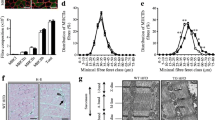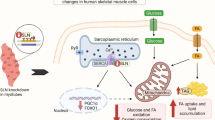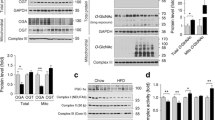Abstract
SIRT1 is known to improve insulin resistance (IR), but whether this effect is direct or not is still unclear, and this question has not been addressed in vivo in the skeletal muscle. Therefore, we sought to test if acute overexpression of SIRT1 in skeletal muscle of high-fat diet (HFD) rats in vivo would affect subsarcolemmal (SS) and intermyofibrillar (IMF) mitochondrial complexes I–V activities and antioxidant enzymes thereby improving insulin action. In vivo electrotransfer was used to overexpress SIRT1 in the skeletal muscle of rats fed HFD for 12 weeks. Skeletal muscle insulin sensitivity and downstream effects of SIRT1 on AMPK, SIRT3, and mitochondrial biogenesis were studied. Citrate synthase (CS), complexes I–V, oxidative stress, and antioxidant levels were assessed in SS and IMF mitochondria. HFD rats showed skeletal muscle IR as well as decreased SIRT1 and SIRT3 expressions, mitochondrial DNA (mtDNA), and mitochondrial biogenesis (p < 0.05). SS and IMF mitochondria displayed lower CS, complexes I–V, and antioxidant enzyme activities (p < 0.05). By contrast, moderate (~2.5 folds) SIRT1 overexpression attenuated HFD-induced skeletal muscle IR. This improvement was associated with increased AMPK, PGC-1α, SIRT3, and mtDNA expressions as well as SS and IMF mitochondrial CS and complexes I–V activities. Importantly, SIRT1 overexpression largely restored antioxidant enzyme activities and enhanced complex I but not complexes II–V functions in individual SS and IMF mitochondria. This study suggests that SIRT1 overexpression improved IR at least partly by targeting complex I functions of SS and IMF mitochondria through the activation of SIRT1 and SIRT3.







Similar content being viewed by others
Abbreviations
- HFD:
-
High-fat diet
- IR:
-
Insulin resistance
- PGC-lα:
-
Peroxisome proliferator-activated receptor-γ coactivator-1α
- ROS:
-
Reactive oxygen species
- SS:
-
Subsarcolemmal
- IMF:
-
Intermyofibrillar
- TA:
-
Tibialis anterior
- SOL:
-
Soleus
- GM:
-
Gastrocnemius
- 2-DG:
-
2-deoxy-d-glucose
- GIR:
-
Glucose infusion rate
- FFA:
-
Free fatty acid
- TG:
-
Triglyceride
- CS:
-
Citrate synthase
- DCPIP:
-
Dichlorophenolindo-phenol
- mtDNA:
-
Mitochondrial DNA
- NRF-1:
-
Nuclear respiratory factor 1
- mtTFA:
-
Mitochondrial transcription factor A
- SOD:
-
Superoxide dismutase
- FBG:
-
Fasting blood glucose
- FINS:
-
Fasting insulin
References
Alcendor RR, Gao S, Zhai P et al (2007) Sirt1 regulates aging and resistance to oxidative stress in the heart. Circ Res 100:1512–1521
Beaudeux JL, Nivet-Antoine V, Giral P (2010) Resveratrol: a relevant pharmacological approach for the treatment of metabolic syndrome? Curr Opin Clin Nutr Metab Care 13:729–736
Cadenas R, Hoy AJ, Turner N et al (2009) Overexpression of carnitine palmitoyltransferase-1 in skeletal muscle is sufficient to enhance fatty acid oxidation and improve high-fat diet-induced insulin resistance. Diabetes 58:550–558
Chen LL, Hu X, Zheng J et al (2010) Increases in energy intake, insulin resistance and stress in rats before Wenchuan earthquake far from the epicenter. Exp Biol Med (Maywood) 235:1216–1223
Chen LL, Zhang HH, Zheng J et al (2011) Resveratrol attenuates high-fat diet-induced insulin resistance by influencing skeletal muscle lipid transport and subsarcolemmal mitochondrial beta-oxidation. Metabolism 60:1598–1609
Cocheme HM, Murphy MP (2008) Complex I is the major site of mitochondrial superoxide production by paraquat. J Biol Chem 283:1786–1798
Dasgupta B, Milbrandt J (2007) Resveratrol stimulates AMP kinase activity in neurons. Proc Natl Acad Sci U S A 104:7217–7222
Do GM, Jung UJ, Park HJ et al (2012) Resveratrol ameliorates diabetes-related metabolic changes via activation of AMP-activated protein kinase and its downstream targets in db/db mice. Mol Nutr Food Res 56:1282–1291
Feige JN, Lagouge M, Canto C et al (2008) Specific SIRT1 activation mimics low energy levels and protects against diet-induced metabolic disorders by enhancing fat oxidation. Cell Metab 8:347–358
Gurd BJ, Yoshida Y, Lally J et al (2009) The deacetylase enzyme SIRT1 is not associated with oxidative capacity in rat heart and skeletal muscle and its overexpression reduces mitochondrial biogenesis. J Physiol 587:1817–1828
Hoeks J, Schrauwen P (2012) Muscle mitochondria and insulin resistance: a human perspective. Trends Endocrinol Metab 23:444–450
Holloway GP, Benton CR, Mullen KL et al (2009) In obese rat muscle transport of palmitate is increased and is channeled to triacylglycerol storage despite an increase in mitochondrial palmitate oxidation. Am J Physiol Endocrinol Metab 296:E738–747
Jing E, Emanuelli B, Hirschey MD et al (2011) Sirtuin-3 (Sirt3) regulates skeletal muscle metabolism and insulin signaling via altered mitochondrial oxidation and reactive oxygen species production. Proc Natl Acad Sci U S A 108:14608–14613
Kong X, Wang R, Xue Y et al (2010) Sirtuin 3, a new target of PGC-1alpha, plays an important role in the suppression of ROS and mitochondrial biogenesis. PLoS One 5:e11707
Li Y, Xu S, Giles A et al (2011) Hepatic overexpression of SIRT1 in mice attenuates endoplasmic reticulum stress and insulin resistance in the liver. FASEB J 25:1664–1679
Li H, Xu M, Lee J et al (2012) Leucine supplementation increases SIRT1 expression and prevents mitochondrial dysfunction and metabolic disorders in high-fat diet-induced obese mice. Am J Physiol Endocrinol Metab 303:E1234–1244
Lionetti L, Mollica MP, Crescenzo R et al (2007) Skeletal muscle subsarcolemmal mitochondrial dysfunction in high-fat fed rats exhibiting impaired glucose homeostasis. Int J Obes (Lond) 31:1596–1604
Murphy MP (2009) How mitochondria produce reactive oxygen species. Biochem J 417:1–13
Nielsen J, Mogensen M, Vind BF et al (2010) Increased subsarcolemmal lipids in type 2 diabetes: effect of training on localization of lipids, mitochondria, and glycogen in sedentary human skeletal muscle. Am J Physiol Endocrinol Metab 298:E706–713
Park SJ, Ahmad F, Philp A et al (2012) Resveratrol ameliorates aging-related metabolic phenotypes by inhibiting cAMP phosphodiesterases. Cell 148:421–433
Philp A, Chen A, Lan D et al (2011) Sirtuin 1 (SIRT1) deacetylase activity is not required for mitochondrial biogenesis or peroxisome proliferator-activated receptor-gamma coactivator-1alpha (PGC-1alpha) deacetylation following endurance exercise. J Biol Chem 286:30561–30570
Price NL, Gomes AP, Ling AJ et al (2012) SIRT1 is required for AMPK activation and the beneficial effects of resveratrol on mitochondrial function. Cell Metab 15:675–690
Purushotham A, Schug TT, Xu Q et al (2009) Hepatocyte-specific deletion of SIRT1 alters fatty acid metabolism and results in hepatic steatosis and inflammation. Cell Metab 9:327–338
Ramsey KM, Mills KF, Satoh A et al (2008) Age-associated loss of Sirt1-mediated enhancement of glucose-stimulated insulin secretion in beta cell-specific Sirt1-overexpressing (BESTO) mice. Aging Cell 7:78–88
Ryan MJ, Jackson JR, Hao Y et al (2010) Suppression of oxidative stress by resveratrol after isometric contractions in gastrocnemius muscles of aged mice. J Gerontol A Biol Sci Med Sci 65:815–831
Schertzer JD, Plant DR, Lynch GS (2006) Optimizing plasmid-based gene transfer for investigating skeletal muscle structure and function. Mol Ther 13:795–803
Sun C, Zhang F, Ge X et al (2007) SIRT1 improves insulin sensitivity under insulin-resistant conditions by repressing PTP1B. Cell Metab 6:307–319
Turk G, Sonmez M, Aydin M et al (2008) Effects of pomegranate juice consumption on sperm quality, spermatogenic cell density, antioxidant activity and testosterone level in male rats. Clin Nutr 27:289–296
Um JH, Park SJ, Kang H et al (2010) AMP-activated protein kinase-deficient mice are resistant to the metabolic effects of resveratrol. Diabetes 59:554–563
van Loon LJ, Koopman R, Manders R et al (2004) Intramyocellular lipid content in type 2 diabetes patients compared with overweight sedentary men and highly trained endurance athletes. Am J Physiol Endocrinol Metab 287:E558–565
White AT, McCurdy CE, Philp A et al (2013) Skeletal muscle-specific overexpression of SIRT1 does not enhance whole-body energy expenditure or insulin sensitivity in young mice. Diabetologia 56:1629–1637
Wright LE, Brandon AE, Hoy AJ et al (2011) Amelioration of lipid-induced insulin resistance in rat skeletal muscle by overexpression of Pgc-1beta involves reductions in long-chain acyl-CoA levels and oxidative stress. Diabetologia 54:1417–1426
Zhang BB, Zhou G, Li C (2009) AMPK: an emerging drug target for diabetes and the metabolic syndrome. Cell Metab 9:407–416
Zheng J, Chen LL, Zhang HH et al (2012) Resveratrol improves insulin resistance of catch-up growth by increasing mitochondrial complexes and antioxidant function in skeletal muscle. Metabolism 61:954–965
Acknowledgments
This work was supported by the National Natural Science Foundation of China grants 81300656 and 81300685.
Author contributions
All authors participated in the design, interpretation of the studies and analysis of the data, and review of the manuscript; H-HZ, P-JD, X-JM, P-YZ, and M-WS conducted the experiments; G-JQ and H-HZ wrote the manuscript.
Conflict of interest
The authors declare that they have no conflict of interest regarding this manuscript.
Author information
Authors and Affiliations
Corresponding author
Rights and permissions
About this article
Cite this article
Zhang, HH., Qin, GJ., Li, XL. et al. SIRT1 overexpression in skeletal muscle in vivo induces increased insulin sensitivity and enhanced complex I but not complex II–V functions in individual subsarcolemmal and intermyofibrillar mitochondria. J Physiol Biochem 71, 177–190 (2015). https://doi.org/10.1007/s13105-015-0396-x
Received:
Accepted:
Published:
Issue Date:
DOI: https://doi.org/10.1007/s13105-015-0396-x




